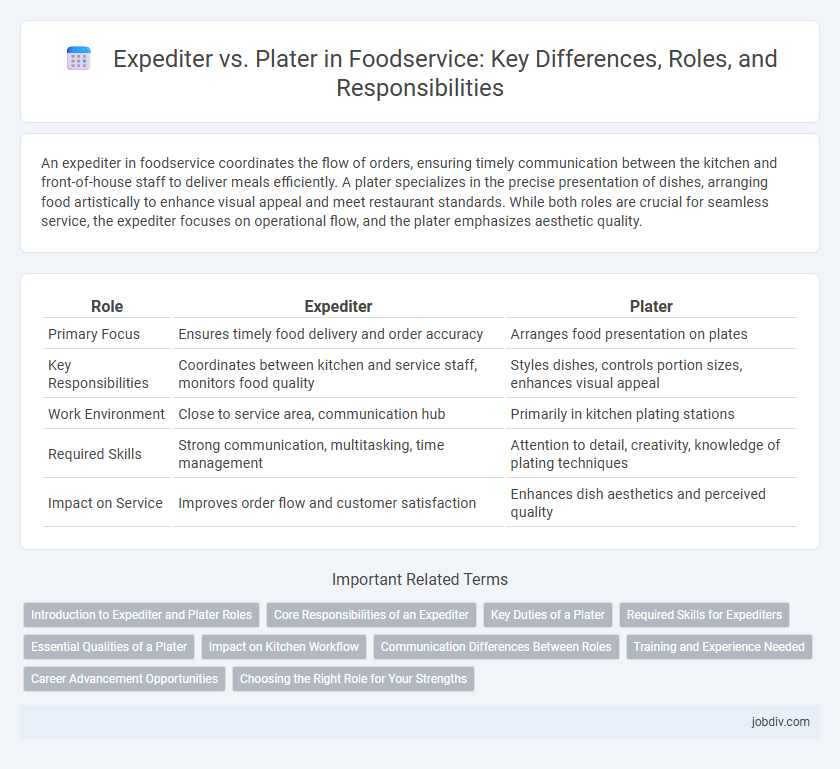An expediter in foodservice coordinates the flow of orders, ensuring timely communication between the kitchen and front-of-house staff to deliver meals efficiently. A plater specializes in the precise presentation of dishes, arranging food artistically to enhance visual appeal and meet restaurant standards. While both roles are crucial for seamless service, the expediter focuses on operational flow, and the plater emphasizes aesthetic quality.
Table of Comparison
| Role | Expediter | Plater |
|---|---|---|
| Primary Focus | Ensures timely food delivery and order accuracy | Arranges food presentation on plates |
| Key Responsibilities | Coordinates between kitchen and service staff, monitors food quality | Styles dishes, controls portion sizes, enhances visual appeal |
| Work Environment | Close to service area, communication hub | Primarily in kitchen plating stations |
| Required Skills | Strong communication, multitasking, time management | Attention to detail, creativity, knowledge of plating techniques |
| Impact on Service | Improves order flow and customer satisfaction | Enhances dish aesthetics and perceived quality |
Introduction to Expediter and Plater Roles
The expediter in foodservice ensures seamless communication between the kitchen and serving staff, coordinating meal timing and quality control to maintain efficient service flow. The plater focuses on the presentation of dishes, arranging food attractively and consistently before it leaves the kitchen. Together, these roles optimize dining experience by balancing operational efficiency and visual appeal.
Core Responsibilities of an Expediter
The core responsibilities of an expediter in foodservice revolve around managing communication between kitchen staff and servers to ensure timely and accurate order delivery. They coordinate the flow of dishes from the kitchen to the dining area, verify plate presentation and quality standards, and handle any last-minute adjustments or special requests. Expediter roles are critical for streamlining operations, minimizing errors, and enhancing customer satisfaction in busy restaurant environments.
Key Duties of a Plater
A plater in foodservice is responsible for arranging and presenting dishes with meticulous attention to detail, ensuring each plate meets the restaurant's standards for appearance and portion size. They coordinate closely with kitchen staff to receive completed dishes, add final garnishes, and verify accuracy before serving. Maintaining consistency and aesthetics on every plate enhances the overall dining experience and supports efficient service flow.
Required Skills for Expediters
Expediters in foodservice require exceptional organizational skills to coordinate timely order flow between kitchen staff and servers, ensuring dishes are prepared and delivered promptly. Strong communication skills are essential for relaying special requests and modifications accurately while maintaining quality control and presentation standards. Expediters must also possess multitasking abilities and keen attention to detail to manage multiple orders simultaneously and resolve any issues efficiently.
Essential Qualities of a Plater
A plater must possess exceptional attention to detail and artistic presentation skills to ensure each dish meets the restaurant's quality standards. Precision in portion control and timing is critical to maintain consistency and freshness. Strong communication with kitchen and service staff enhances workflow efficiency and customer satisfaction.
Impact on Kitchen Workflow
An expediter enhances kitchen workflow by coordinating orders between chefs and servers, ensuring timely preparation and delivery of dishes. A plater focuses solely on the presentation and final assembly of food, which can slow the process if not well integrated with order flow. Effective use of an expediter streamlines communication and reduces errors, significantly improving kitchen efficiency compared to relying only on platers.
Communication Differences Between Roles
Expediter roles prioritize clear and timely communication between kitchen staff and servers to ensure accurate and efficient order completion. Platers focus on detailed coordination with chefs to present dishes according to specific quality and presentation standards. Effective communication in these roles minimizes errors and enhances overall service workflow in busy foodservice environments.
Training and Experience Needed
Expediter roles in foodservice require strong communication skills and experience in managing workflow between kitchen and dining areas, ensuring timely delivery and order accuracy. Platers need a keen eye for detail and training in food presentation techniques to enhance visual appeal and maintain portion consistency. Both positions benefit from hands-on kitchen experience, but expediters often require more advanced multitasking and coordination skills.
Career Advancement Opportunities
Expediters in foodservice develop strong organizational and communication skills by coordinating kitchen and floor operations, positioning them for roles like kitchen manager or restaurant operations manager. Platers hone precision and presentation expertise, which can lead to careers in culinary arts, such as sous chef or executive chef. Both roles serve as critical stepping stones, offering unique skill sets that pave the way for diverse career advancement opportunities in the hospitality industry.
Choosing the Right Role for Your Strengths
Choosing between an expediter and a plater in foodservice depends on your strengths in organization and attention to detail. An expediter excels at coordinating communication between the kitchen and front-of-house, ensuring timely order delivery and workflow efficiency. Platers focus on precise food presentation and portion control, ideal for those with a keen eye for aesthetics and consistency.
Expediter vs Plater Infographic

 jobdiv.com
jobdiv.com